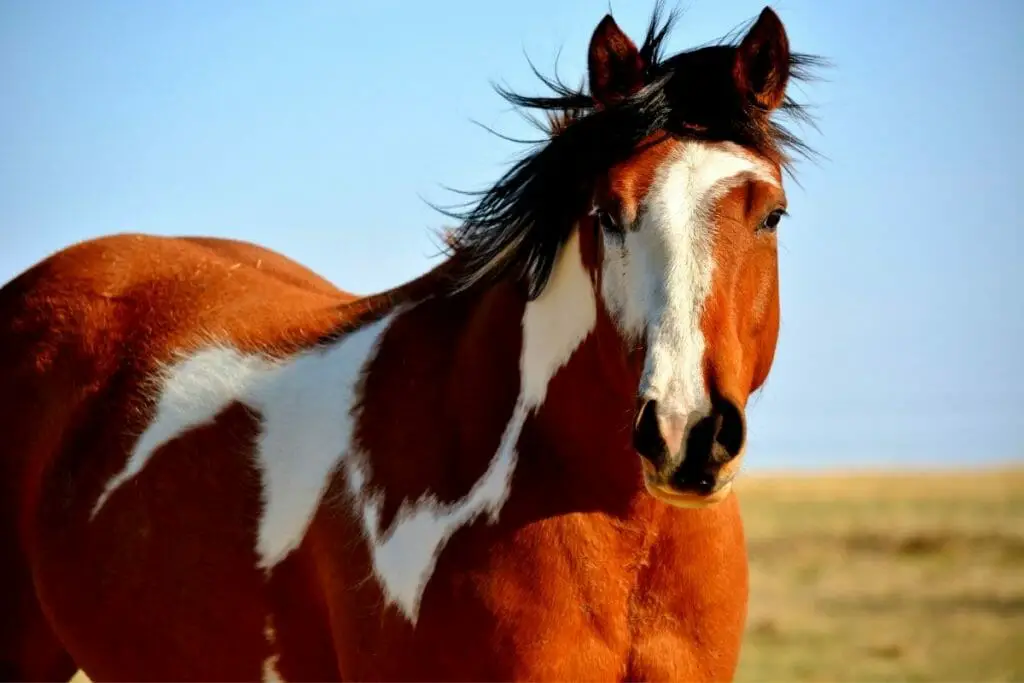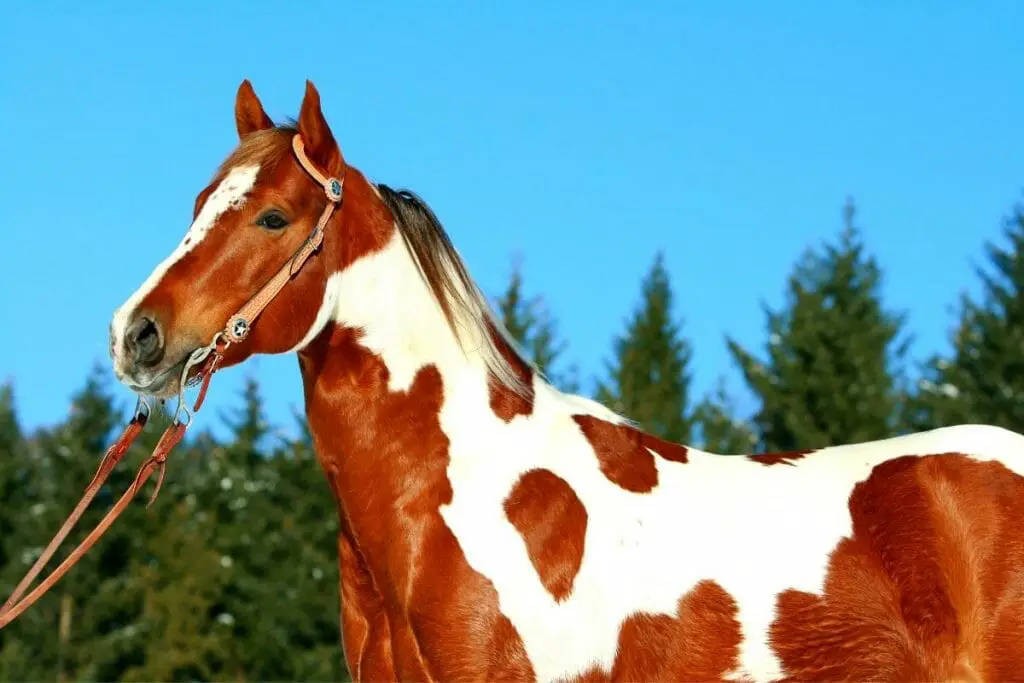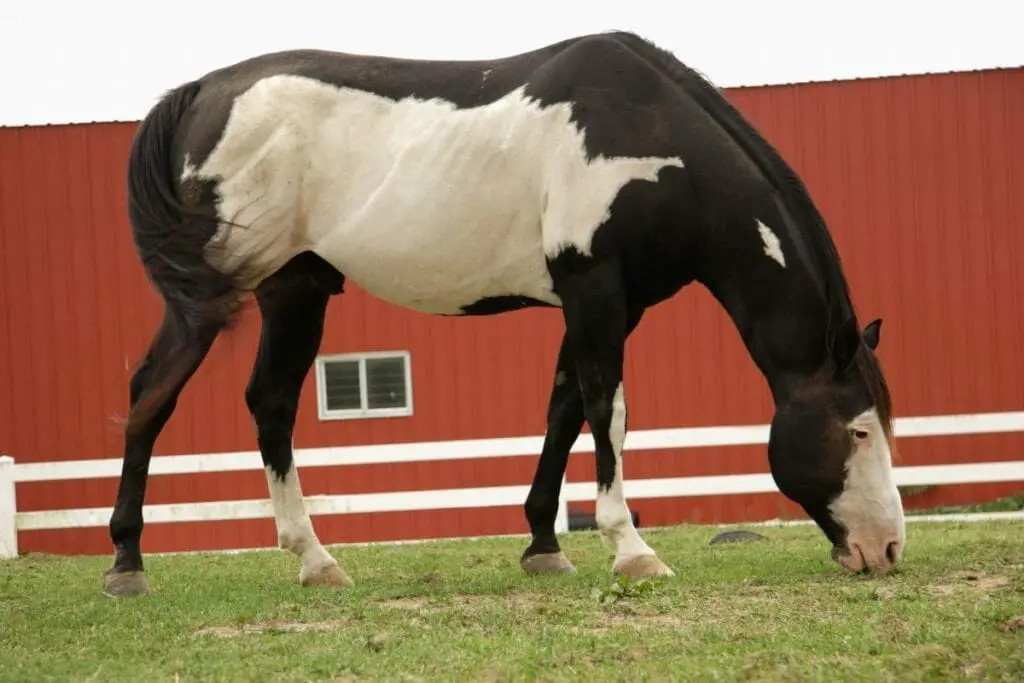The American Paint Horse is a registered breed of horse popularly known for its distinctive coat colorations.
Many people enjoy their impressive appearance, which sometimes seems to explode with color and vibrancy. In terms of the different color patterns, pretty much anything you can imagine is possible. Markings can be of any shape and size and can be present in just about any location on the horse’s body.
The characteristic coat color patterns of the ‘Paint Horse’ are created by a combination of white and any other color. These colors include grey, black, bay, brown, chestnut, and dilution colors include palomino and buckskin. While some horses impressively display two colors and, of course, white, others may have a solid single-colored coat and exhibit no “patterns” or “patches” at all.
At first glance, trying to identify and name the different color patterns found in American Paint Horses can seem a little intimidating, but there is no need for alarm.
They can be broken down into three main categories. These are tobiano, overo, and tovero. The overo coloration contains three further sub-categories.
American Paint Horse: Paint Vs Pinto?

Before we get into the different coat color patterns found in The American Paint horse, there is something that we need to clear up.
The terms ‘paint’ and ‘pinto’ often get mixed up. It is necessary to understand the difference between these two terms when exploring the various color patterns.
The term ‘Paint’ refers to the breed (the American Paint Horse).
‘Pinto’ refers to the presence of color combinations (variations or patches of color and white), regardless of the breed of horse.
The Pinto Horse Association is a color registry for horses, and horses of any breed can be registered. The American Paint Horse Association is a registry for the breed itself. The two registries are independent of each other (although an American Paint Horse may be registered with both).
American Paint Horse: Registration According to Color

The APHA (American Paint Horse Association) is the second-largest breed registry in the United States. In order for a horse to qualify for registration, they need to meet several strict criteria and breed characteristics.
These include parentage, conformation, and yes, color (which is what it’s all about, right?). There are two categories of registration. Horses are registered according to their specific color type and/or their patterns;
Regular Paint Horse
Horses who exhibit “color” or “natural paint markings” will qualify for this type of registration. This means the horse has either a predominantly white coat with the presence of patches of at least one other color; or a predominantly colored coat with the presence of white patches. We will explore the color variations and patterns below.
There are two main terms to describe the colors of a paint or pinto coat, skewbald and piebald.
Skewbald Paint Horse

Includes white and any other patches of color except for white and black.
Skewbald can also include tri-colors, which is patches of white over any two other colors. Only in this circumstance, may black be included.
Piebald Paint Horse

Is white patches only over a black coat. So a black and white horse.
Solid Paint-Bred
This is for horses who have a solid-colored coat, in other words, no patches. These horses must adhere to certain restrictions concerning showing and breeding.
The Three Main Types of Coat Color Patterns of the American Paint Horse

The APHA has broken down the color patterns found in the American Paint Horse into three main categories.
The three main types of coat color patters are the:
- tobiano (which is the most common)
- overo (further broken down into three categories)
- tovero or tobero (a mixture of tobiano and overo).
These colorations are produced by the different genes present in particular blood-lines.
Tobiano and overo patterned horses differ in a few simple ways. Let us look at a few general guidelines you can use when identifying the different coat color patterns.
| Tobiano | Overo | |
| General | The coat comprises a mixture of solid-color and white patches, separated by clear, distinct borders. | A mixture of color and white, the patches seem to be more ‘splashed’ than solid in shape and can have more irregular, unrefined borders. |
| The Back | The white areas extend over the horse’s top- line (which begins at the poll and ends at the tail), crossing over the back. | Typically, the white coloration seems to originate at the belly and will not cross over the horse’s top-line. |
| The Legs | Their lower-legs are white. | At least one (or even all four) of the legs are predominantly colored. |
| The Face | Tobianos have a solid-colored face showing regular facial markings, such as a star, strip, or blaze. | Bold white head markings are characteristic of overo horses. A bald face (entirely white) is not an uncommon sight. |
| The Eyes | Eyes are dark in color. | Very often, either one or both eyes are partially-blue or blue. |
| The Mane & Tail | There are usually two colors present in the mane tail. | The tail is usually a single solid color. |
| General Color | They can be either predominantly white or dark in color. | Like the tobiano, they can be either predominantly white or dark in color. |
Tobiano Paint Horse

Tobianos usually has normal face markings such as blazes, stars, strips and snips, the white patches on the body are more rounded off and vertically placed, and the legs tend to be white.
Tobianos many times have more white than color on the body.
Bay and white tobianos tend to be called tricolored, because of the black mane and tail, and the bay and white patches.
Overo Paint Horse Variations
There are three variations within the Overo coat coloration: frame overo, sabino overo, and splashed white overo.
Frame Overo Paint Horse

This is the most common overo pattern. These horses have a predominantly base-colored coat (chestnut, bay, etc.) with sharp jagged-edged white patches that seem to spread horizontally across the body.
Sabino Overo Paint Horse

The coats of sabino overo horses often display a type of coloration similar in appearance to ‘roaning’ around their mid-section. Roaning is a mixture of white and colored hair.
The coloration is very light around the belly of the horse, growing darker toward the top side. Bold white facial markings are typical, as are blue or partially blue eyes. They generally have four white feet.
Splashed White Overo Paint Horse

These horses are easily recognized by the base-colored topside of the body, which changes dramatically to white toward the horse’s underside. These horses usually have four white legs. There are often bold white facial markings, often encompassing most of the face and extending past blue eyes.
Not all Paint color patterns fall precisely into one of these two categories; therefore, the APHA decided to expand their classifications to include a third, which is tovero.
Tovero Paint Horse

The tovero horse (also known as tobero) possesses either a mixture of characteristics from both tobiano and overo patterns and colorations or does not fall into one of these classifications. For example, a horse with a dark head (Tobiano) and blue eyes (Overo).
A horse with white over his back (Tobiano) and a white face (Overo). The horse may be almost entirely white and only display color on his ears, muzzle, and chest.
Characteristics Of A Tovero Paint Horse
The Face
A white head with color around the ears, forehead, and eyes. Either one or both eyes may be blue. There may be some color around the mouth, with spots of color extending up the sides of the face.
Conversely, the head may also be a solid color, with blue eyes and white ears.
The Body
Chest patches or spots, which may extend upward toward the head.
Flank patches or spots, which may extend over the quarters and forward toward the belly.
Medicine Hat Marking

The medicine hat is a marking that is commonly seen in overos, but it can be seen in any of the pinto patterns.
The horse typically has a bald face with a marking covering the top of it’s head that makes it look like it is wearing a hat.
Where Did The Paint Colorations Originate?

The origins of the American Paint horse are traced back to colored horses brought to North America by the Spanish Explorers. Some of these horses escaped and turned wild on the Great Plains, creating vast herds.
Hardy and tough, they became a popular working animal of the Western Frontier, prized by both the Native Americans and cowboys alike. It was not uncommon to see these colored horses charging alongside great herds of buffalo or driving great herds of cattle over long distances.
Over time, and with selective breeding, their conformation, versatility, and athletic ability, and of course, the characteristic patchy coloring were tailor-designed into the breed of horse we see today.
American Paint horses are often bred with American Quarter Horses and Thoroughbreds, adding stockiness and height, respectively, to the breed.
Strict standards regarding lineage are in place, making only horses with the correct parentage, conformation, and color eligible for registration (for either regular or solid paint-bred). Both parents need to be registered with the APHA, the American Quarter Horse Association, or the Jockey Club (for Thoroughbreds) to qualify for registration with the APHA.
Conclusion

The American Paint Horse is a fantastic and versatile breed of horse, their distinctive coloration being their most notable attribute. After all, the breed was named for it.
They come in almost any color variation imaginable, and they are eye-catching, flashy, and beautiful, making them a popular addition to any bard.
When identifying the coat pattern, take it step by step and systematically assess the horse. Practice makes perfect, and you will soon get the hang of it.
Do you ride a paint horse? What coat pattern does your paint have? Let us know in the comments.
Cheers, Kacey
Related Blog Posts
- Complete Guide To Horse Coat Colors & Patterns: FAQ’s Included
- Bay Horses 101: Learn All About The Beautiful Shades Of Bay
- 16 Dapple Grey Horse Facts With Beautiful Pictures | Breeds List | Resources
- What Is A Flea Bitten Grey Horse? Grey Horse Breeds, Facts, Colors & Photos
- Learn 10 Facts, Differences & Color Shades Of Buckskin & Dun Horses
- 27 Interesting Palomino Horse Facts With Beautiful Pictures & Some Extras
- Horse Face and Leg Markings Chart
- All About Blue Roan Horses (Genetics, Facts, Breeds & More!)

